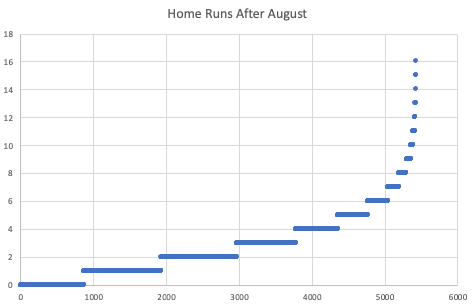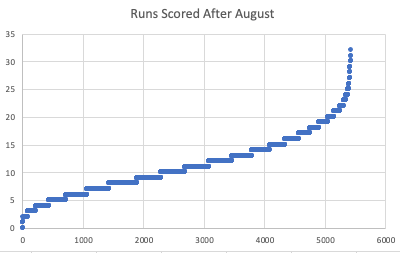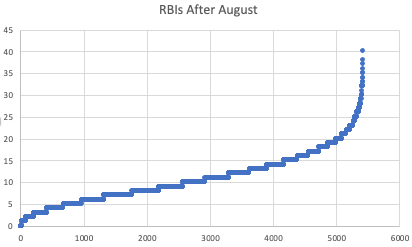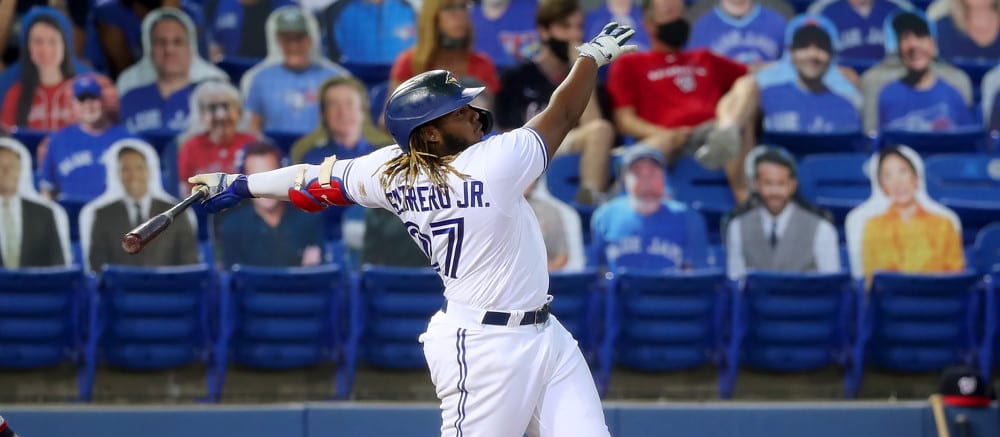This article is part of our Collette Calls series.
I am well aware that it is fantasy football draft season. I have two drafts in the next six days and am leaning HEAVILY on our draft resources here at RotoWire because I have given football very little attention this summer as I am having one of my best fantasy baseball seasons in recent memory with multiple teams in contention for a league title. I know that does not apply to some reading this installment, but just because your team might not have a chance at winning means that you can ignore your baseball team. You are likely in a league with friends, so bragging rights are out there. You might have a fun league where the last place team has an extra penalty of a financial or embarrassing nature. This week, we were asked to opine on advice for the stretch run in the Tout Table, and I offered up this advice:
Do what you can to impact the standings wherever you can, even if you're out of contention for the title. If you can impact the overall race by adjusting your lineup to focus on a particular area, it makes the league more entertaining. There is nothing more infuriating than watching teams give up and move onto that devil sport foosball when they can still make a difference in the final outcome of the league.
September matters. Your team might not be able to win the league, but you can make an impact in the final standings
I am well aware that it is fantasy football draft season. I have two drafts in the next six days and am leaning HEAVILY on our draft resources here at RotoWire because I have given football very little attention this summer as I am having one of my best fantasy baseball seasons in recent memory with multiple teams in contention for a league title. I know that does not apply to some reading this installment, but just because your team might not have a chance at winning means that you can ignore your baseball team. You are likely in a league with friends, so bragging rights are out there. You might have a fun league where the last place team has an extra penalty of a financial or embarrassing nature. This week, we were asked to opine on advice for the stretch run in the Tout Table, and I offered up this advice:
Do what you can to impact the standings wherever you can, even if you're out of contention for the title. If you can impact the overall race by adjusting your lineup to focus on a particular area, it makes the league more entertaining. There is nothing more infuriating than watching teams give up and move onto that devil sport foosball when they can still make a difference in the final outcome of the league.
September matters. Your team might not be able to win the league, but you can make an impact in the final standings the final month of the season so that the eventual winner has to sweat things out to the final day. I have been in leagues where the winner was decided by a single strikeout, and I have even won a league when a runner was thrown out at home and my tie in the runs scored category was preserved and I won the league by half a point.
The last 20 seasons, we have seen several big final weeks to the season for many players in each of the 10 standard scoring categories. A single player can move the needle in a single-league format whereas you likely need a combination of players on your roster to get hot to make it happen in mixed leagues. The new rules limiting full roster expansion in September somewhat impacts things because we should not see as many inexperienced pitchers on the roster now that clubs can only expand by two players after Sept. 1, but that could be offset by the increase of tired arms we already see on the mound (Matt Barnes anyone?). All statistical probabilities for hitters below are used with a qualifier of at least 50 PA.
Home Runs
1.3 percent of all qualified hitters the last 20 seasons have gone on hit at least 10 homers in the final weeks of the season. That group is led by J.D. Martinez with 16 homers for Arizona in 2016 and was most recently accomplished by the quintet of Adam Duvall, AJ Pollock, Marcell Ozuna, Jose Ramirez and Pete Alonso last season. In fact, in each of the last two seasons, we have seen at least five batters hit 10 or more home runs while some seasons have seen nobody accomplish the feat:
| Season | Players with 10+ HR After August |
| 2002 | 4 |
| 2003 | 2 |
| 2004 | 1 |
| 2005 | 6 |
| 2006 | 5 |
| 2007 | 7 |
| 2008 | 1 |
| 2009 | 3 |
| 2010 | 2 |
| 2011 | 2 |
| 2012 | 5 |
| 2013 | 2 |
| 2015 | 4 |
| 2016 | 7 |
| 2017 | 4 |
| 2018 | 3 |
| 2019 | 5 |
| 2020 | 5 |
The average homer total of the player pool was 2.7, but we have still seen some surprising closes to the season including Chris Carter in 2016, the Upton brothers in 2012 (BJ) and 2016 (Justin), and Randy Winn in 2005.

If you're looking for 2021 possibilities, Teoscar Hernandez and Vladimir Guerrero Jr jump off the page as 16 of their final 30 games come at Rogers Centre and they still have eight more matchups against Baltimore along with a four-game road trip to Yankee Stadium. Maybe C.J. Cron can do it as well given the Rockies have 16 home games in September with road trips to Philadelphia and Atlanta while finishing the season with three games in Arizona. As it were, Crush Job Cron is hitting .353/.434/.718 the last 30 days!
Runs
Fifty-one players have scored 25 or more runs after August in the last 20 seasons, led by Jimmy Rollins in 2005, who bested the 31 runs scored by Garrett Atkins (??!!) in 2006 and Derek Jeter in 2004. Ronald Acuna Jr was the only player to reach that total last season, and Marcus Semien was the only one who did so in 2019 despite that season being the most offensive-friendly one in recent memory. All in all, we have not seen nearly the same level of activity in this category as we have home runs, which is a sign of the game's ever-increasing struggle to string together positive baseball activities on the field around strikeouts:
| Season | Players with 25+ Runs After August |
| 2002 | 1 |
| 2003 | 1 |
| 2004 | 5 |
| 2005 | 7 |
| 2006 | 6 |
| 2007 | 4 |
| 2008 | 2 |
| 2009 | 4 |
| 2010 | 1 |
| 2011 | 3 |
| 2012 | 3 |
| 2013 | 1 |
| 2015 | 6 |
| 2016 | 1 |
| 2017 | 3 |
| 2018 | 1 |
| 2019 | 1 |
| 2020 | 1 |
If I am looking at Toronto for home-run possibilities, then it makes sense to look for Semien to possibly repeat his efforts this season. We could also look at Jorge Polanco, Jonathan India or even the current leader for runs scored over the past 30 days — Wander Franco. The average player in the data set scored 11 runs, so this has been a tougher category to close the gap on than homers in recent seasons:

RBIs
One hundred thirty-three players have driven in at least 25 runs after August the last 20 seasons, which is 2.5 percent of the overall sample size, making it nearly twice the chance of a player hitting 10 or more home runs. The group is led by the unforgettable close to the 2010 season by Troy Tulowitzki as he drove in 40 runs (while scoring 30 and hitting 15 homers) and the quintet of Marcell Ozuna, Freddie Freeman, Jose Abreu, Jared Walsh and Luke Voit accomplished it in 2020. The Walsh name likely surprised you as much as it did me when I looked at the data, but it is a good reminder that RBIs are as much about opportunity as they are anything else:
| Season | Players with 25+ RBIs After August |
| 2002 | 5 |
| 2003 | 1 |
| 2004 | 11 |
| 2005 | 12 |
| 2006 | 15 |
| 2007 | 16 |
| 2008 | 6 |
| 2009 | 11 |
| 2010 | 7 |
| 2011 | 2 |
| 2012 | 6 |
| 2013 | 2 |
| 2014 | 2 |
| 2015 | 8 |
| 2016 | 9 |
| 2017 | 7 |
| 2018 | 5 |
| 2019 | 3 |
| 2020 | 5 |
The overall probability is driven more by the early years than recent seasons as demonstrated by the table above. The offensive environment in the league has changed since 15 years ago, so while the overall percentage is enticing, recent years tell us that big RBI production down the stretch is more improbable than it was 15 years ago. To put things in perspective, the RBI leaders over the last 30 days are Dansby Swanson, Joey Votto and C.J. Cron. Each hitter is red hot in their own right, and they each have 30 RBIs the last 30 days.

Steals
This one is a tricky category because we are all likely thinking most big September steals came early in the data set. Just 1 percent of players have stolen at least 10 bases after August in a given season the last 20 years with Everth Cabrera and Scott Podsednik atop the leaderboard with 19 steals in 2012 and 2004, respectively. While the data is mostly front-loaded on the table below, we are not so far removed from multiple players influencing this category down the stretch:
| Season | Players with 10+ Steals After August |
| 2002 | 3 |
| 2003 | 3 |
| 2004 | 1 |
| 2005 | 5 |
| 2006 | 4 |
| 2007 | 7 |
| 2008 | 1 |
| 2009 | 3 |
| 2010 | 4 |
| 2011 | 6 |
| 2012 | 4 |
| 2013 | 3 |
| 2015 | 2 |
| 2016 | 4 |
| 2017 | 1 |
| 2018 | 4 |
| 2019 | 1 |
| 2020 | 1 |
In each of the last two seasons, the same player was the sole factor in this category and should once again be at the top of the list to do so in 2021. Adalberto Mondesi has missed nearly the entire season with oblique injuries, so he may do nothing but run in September as he has done each of the last two seasons. He could also get injured reaching into his back pocket for his sliding mitt. I rostered him in AL Tout Wars and it has been painful to see him sit on my IL all season, but in each of the last three seasons, he has stolen at least 12 bases after August. Mondesi was joined in 2018 by Mallex Smith (now with Toronto), teammate Whit Merrifield and Jonathan Villar. The good news is each of them is still in the league and perhaps Toronto is envisioning using Smith as a designated runner in September. Merrifield continues to run this year and has 12 steals over the last month but is still well behind the 18 steals from Starling Marte in that same timeframe. The only other player with at least 10 steals over the last month — Nicky Lopez. Admittedly, this is a very tough category to make up late in the season, not to mention in the current era of baseball where teams are reticent to give away outs and stand around waiting for the home run.
In short, you have a responsibility as a fantasy owner to manage your team over the course of the entire season. Even if you cannot win your league, you should make it as difficult as possible for another team to do so. Using AL Tout Wars as an example, Rick Wolf and Glenn Colton currently hold a five-point lead over Chris Liss in the league. The 10th-place team sits 15 RBIs behind Liss, but 16 runs in front of Colton and Wolf, so he can factor in the race. Colton and Wolf cannot be caught in RBIs with their 74-RBI lead, but Liss is just 12 RBIs behind two teams in front of him that are currently 6th and 10th in the overall standings. Liss is holding onto a four-steal lead over the 11th-place team in the overall standings, but things are most interesting in home runs. Liss is a distant second with 196 homers, but Colton and Wolf are just a homer behind him while two other teams in the lower half of the overall standings are within single digits of both teams in the home run total. AL Tout Wars has become a two-team race, but many teams have the opportunity to influence the final outcome of the race in the hitting categories.










